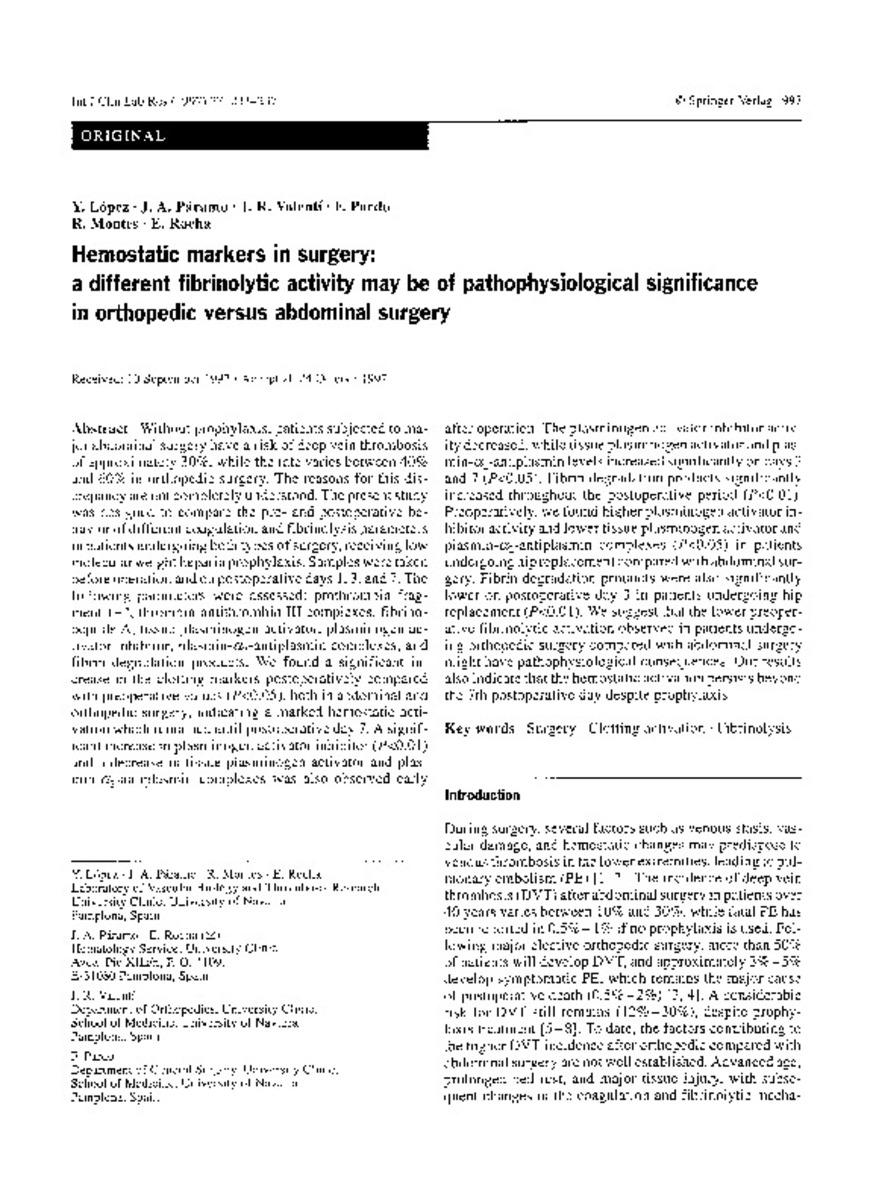Full metadata record
| DC Field | Value | Language |
|---|---|---|
| dc.creator | Lopez, Y. (Yolanda) | - |
| dc.creator | Paramo, J.A. (José Antonio) | - |
| dc.creator | Valenti-Nin, J.R. (Juan Ramón) | - |
| dc.creator | Pardo, F. (Fernando) | - |
| dc.creator | Montes, R. (Ramón) | - |
| dc.creator | Rocha, E. (Eduardo) | - |
| dc.date.accessioned | 2012-05-30T15:17:21Z | - |
| dc.date.available | 2012-05-30T15:17:21Z | - |
| dc.date.issued | 1997 | - |
| dc.identifier.citation | Lopez Y, Paramo JA, Valenti JR, Pardo F, Montes R, Rocha E. Hemostatic markers in surgery: a different fibrinolytic activity may be of pathophysiological significance in orthopedic versus abdominal surgery. Int J Clin Lab Res 1997;27(4):233-237. | es_ES |
| dc.identifier.issn | 1434-4467 | - |
| dc.identifier.uri | https://hdl.handle.net/10171/22337 | - |
| dc.description.abstract | Without prophylaxis, patients subjected to major abdominal surgery have a risk of deep vein thrombosis of approximately 30%, while the rate varies between 40% and 60% in orthopedic surgery. The reasons for this discrepancy are not completely understood. The present study was designed to compare the pre- and postoperative behavior of different coagulation and fibrinolysis parameters in patients undergoing both types of surgery, receiving low molecular weight heparin prophylaxis. Samples were taken before operation and on postoperative days 1, 3, and 7. The following parameters were assessed: prothrombin fragment 1 + 2, thrombin-antithrombin III complexes, fibrinopeptide A, tissue plasminogen activator, plasminogen activator inhibitor, plasmin-alpha 2-antiplasmin complexes, and fibrin degradation products. We found a significant increase in the clotting markers postoperatively compared with preoperative values (P < 0.05), both in abdominal and orthopedic surgery, indicating a marked hemostatic activation which remained until postoperative day 7. A significant increase in plasminogen activator inhibitor (P < 0.01) and a decrease in tissue plasminogen activator and plasmin-alpha 2-antiplasmin complexes was also observed early after operation. The plasminogen activator inhibitor activity decreased, while tissue plasminogen activator and plasmin-alpha 2-antiplasmin levels increased significantly on days 3 and 7 (P < 0.05). Fibrin degradation products significantly increased throughout the postoperative period (P < 0.01). Preoperatively, we found higher plasminogen activator inhibitor activity and lower tissue plasminogen activator and plasmin-alpha 2-antiplasmin complexes (P < 0.05) in patients undergoing hip replacement compared with abdominal surgery. Fibrin degradation products were also significantly lower on postoperative day 3 in patients undergoing hip replacement (P < 0.01). We suggest that the lower preoperative fibrinolytic activation observed in patients undergoing orthopedic surgery compared with abdominal surgery might have pathophysiological consequences. Our results also indicate that the hemostatic activation persists beyond the 7th postoperative day despite prophylaxis. | es_ES |
| dc.language.iso | eng | es_ES |
| dc.publisher | Springer Verlag | es_ES |
| dc.rights | info:eu-repo/semantics/openAccess | es_ES |
| dc.subject | Surgery | es_ES |
| dc.subject | Clotting activation | es_ES |
| dc.subject | Fibrinolysis | es_ES |
| dc.title | Hemostatic markers in surgery: a different fibrinolytic activity may be of pathophysiological significance in orthopedic versus abdominal surgery | es_ES |
| dc.type | info:eu-repo/semantics/article | es_ES |
| dc.relation.publisherversion | http://www.springerlink.com/content/r08qu472733x4070/?MUD=MP | es_ES |
| dc.type.driver | info:eu-repo/semantics/article | es_ES |
Files in This Item:
Statistics and impact
Items in Dadun are protected by copyright, with all rights reserved, unless otherwise indicated.






